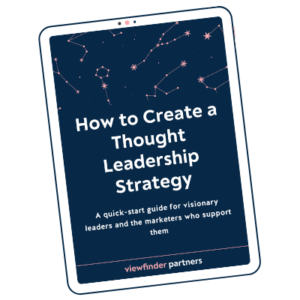When you look ahead at next year, you could probably name a few business goals. But what are your thought leadership goals?
When I talk about thought leadership goals, I’m really asking: What would happen if more people knew about your ideas? What could you accomplish?
A lot of people want to “be a thought leader,” but what’s driving that desire? What are you trying to accomplish in your business, and how will thought leadership help you get there?
Are you trying to…
- Grow your existing business?
- Sell something new?
- Drive awareness of a specific product or service?
- Convince people of something?
- Influence people to change their behavior?
- Create a new niche or category in your industry?
- Expand your audience and reach new people?
- Profit directly from your thought leadership by scheduling more paid speaking events or writing a book?
Try this exercise
Let’s set a thought leadership goal for the new year. You’ll need 6 minutes and an open mind.
Ready?
Set a timer for 3 minutes and brainstorm your answer to this prompt:
GOALS: What would happen if more people knew about your ideas? What could you accomplish?
[list your dreams, goals, and big aspirations]
[DING!] After 3 minutes, look back on your answer.
Now, let’s take one more step. Set another 3-minute timer and brainstorm:
ACTIONS: What actions could you take in January to move you toward those goals? What habits could you start? What baby steps could you start to take?
[list the actions you could take]
[DING!] When you’re done, look back at your list. Could you put any of those actions on your January calendar? Could you break them into 30-minute micro-tasks that you can schedule into your work week in the new year? Look for ways to create new little habits that will push you closer to your goals.
Set a reminder to check in on your goals on February 1st and recalibrate.
Example: Using thought leadership to do more than sell
Here’s an example of how an aspiring thought leader might do this exercise:
Let’s say you’re the founder of a legal tech company. Your core product helps lawyers track billable hours. You have business goals to grow revenue and the number of customers.
But what would happen if more people knew about WHY you started the company? What are your thought leadership goals?
You could:
- Start a broader conversation in the industry about why billing needs to change.
- Advocate for more transparency and access for clients who need legal representation.
- Learn more about what your potential buyers need from your platform by connecting with people about their frustrations.
- Partner with other companies doing similar work or solving similar challenges.
Now, what are actions you could take to develop your thinking and share it with people in your industry?
You could:
- Spend 20 minutes at the end of every work day writing, noting your reflections on why you started the business, what you’re hearing in sales conversations, and your vision for change.
- Experiment with a consistent publishing channel to share those reflections — on your LinkedIn, in your company’s email newsletter, in your brand account’s Instagram stories, in a monthly blog post on the company blog.
- Respond to other thought leaders who are addressing these issues. Could you spend 10 minutes a week reading and responding to other people’s LinkedIn posts?
- Build connections with gatekeepers in your industry’s media world. Who are the magazine editors, trade show organizers, and influencers in your industry? How could you get to know them and start conversations that could lead to published bylines, interviews, or speaking opportunities?
When you think bigger about where your ideas could take you, it’s easier to break down micro-actions to take you there.
This exercise is featured in my quickstart guide, How to Create a Thought Leadership Strategy. Download it below.
Learn how to use your ideas as a calling card



![target practice [thought leadership is a practice]](https://viewfinderpartners.com/wp-content/uploads/2024/02/get-unstuck-300x300.png)



